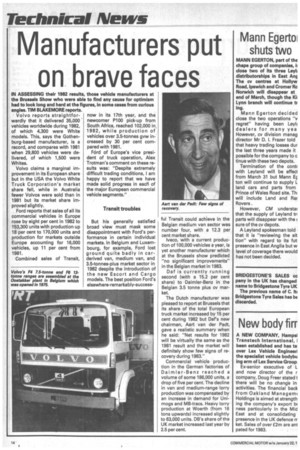Manufacturers pu on brave faces
Page 16

If you've noticed an error in this article please click here to report it so we can fix it.
IN ASSESSING their 1982 results, those vehicle manufacturers at the Brussels Show who were able to find any cause for optimism Volvo reports straightforwardly that it delivered 35,000 vehicles worldwide during 1982, of which 4,300 were White models. This, says the Gothenburg-based manufacturer, is a record, and compares with 1981 when 29,800 vehicles were delivered, of which 1,500 were Whites.
Volvo claims a marginal improvement in its European share but in the USA the Volvo White Truck Corporation's market share fell, while in Australia fewer Volvos were sold than in 1981 but its market share improved slightly.
Ford reports that sales of all its commercial vehicles in Europe' rose by eight per cent in 1982 to 153,300 units with production up 18 per cent to 170,000 units and production for markets outside Europe accounting for 16,000 vehicles, up 11 per cent from 1981.
Combined sales of Transit, now in its 17th year, and the newcomer P100 pick-up from South Africa, reached 102,000 in 1982, while production of vehicles over 3.5-tonnes gvw increased by 30 per cent compared with 1981.
Ford of Europe's vice president of truck operation, Alex Trotman's comment on these results was: "Despite extremely difficult trading conditions, I am happy to report that we have made solid progress in each of the major European commercial vehicle segments."
Transit troubles But his generally satisfied broad view must mask some disappointment with Ford's performance in certain individual markets. In Belgium and Luxembourg, for example, Ford lost ground quite badly in carderived van, medium van, and 3.5-tonnes-plus market sector in 1982 despite the introduction of the new Escort and Cargo models. The best position Ford's elsewhere-remarkably-success
ful Transit could achieve in the Belgian medium van sector was number four, with a 12.3 per cent market share.
lveco, with a current production of 100,000 vehicles a year, is yet another manufacturer which at the Brussels show predicted "no significant improvements" in the Belgian market in 1983.
Daf is currently running second (with a 15.2 per cent share) to Daimler-Benz in the Belgian 3.5 tonne plus cv market.
The Dutch manufacturer was pleased to report at Brussels that its share of the total European truck market increased by 15 per cent during 1982 but Daf's new chairman, Aart van der Padt, gave a realistic summary when he said: "Net results for 1982 will be virtually the same as the 1981 result and the market will definitely show few signs of recovery during 1983."
Commercial vehicle production in the German factories of Daimler-Benz reached a volume of some 186,000 units, a drop of five per cent. The decline in van and medium-range lorry production was compensated by an increase in demand for Uni mogs and MB-tracs. Heavy lorry production at Woerth (from 16 tons upwards) increased slightly to 63,000 units. DB's share of the UK market increased last year by 2.5 per cent.




















































































